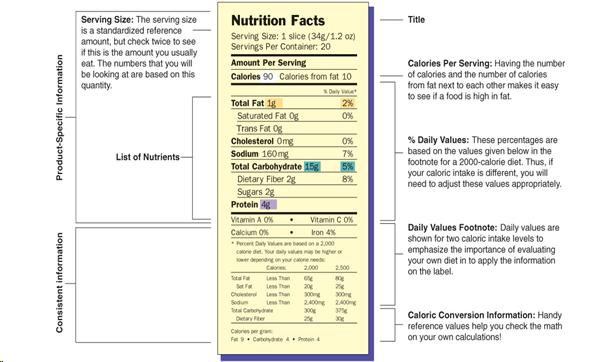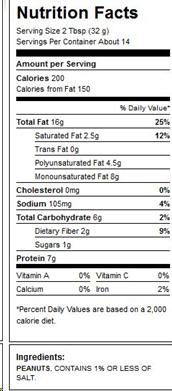Lecture Notes
Being able to read the nutrition facts label that's provided on any manufactured food in the US (it's required to be on any manufactured food), so reading that nutrition label and in addition to that, the ingredient list that's on that packaged food is so important for helping to plan a nutritious diet.
And, so like I said, all manufactured food in the United States is required to have these labels for you, the consumer. But, the labels are no good if you don't read them. For example, if you look at the nutrition facts, a few things that you want to pay attention to, or you should be able to look at pretty easily—the serving size on the package. Oftentimes there are multiple servings in a box or a bag of packaged food, and you need to know how much you're eating and what fat, cholesterol, sodium, carbohydrate, all of your nutrients are in that one serving. If you eat multiple servings, you also need to adjust your nutrition information accordingly that's provided on the label. And so there's more information about how to do this in the book.
Also on this nutrition fact sheet you'll find the calories. Again, these are calories per serving, so understanding these calories can help you stay in your energy balance, which we'll talk about in the next chapter. All of the macronutrients are included on this nutrition facts panel, so your fats, your carbohydrates, and your protein are all included, and you should pay particular attention to not only how much fat is there in the product but is it saturated fat, is it unsaturated fat, is it trans fat. You should also pay attention to the type of carbohydrate you're eating. Is it considered fiber or sugar? Obviously higher fiber and lower sugar would be better. So, that's the nutrition facts panel.
If we're talking about the ingredient list, the simplest way to judge an ingredient list would be to look for the number of ingredients on that list. In most cases, fewer ingredients in a processed food is probably going to be better. Again, that's not across the board, but in most cases.
So, for example, let's compare these two lists. Both are peanut butter, okay? So, you have your list on the left, and for this we'll just look at the ingredients; we won't look at the nutrition facts. The list on the left is peanut butter and contains two percent or less of salt. So you basically, in your peanut butter, have peanuts and salt. On the right you have many more ingredients. And what you see there, any time you see any kind of, the word "hydrogenated," you know that there are trans fats in that product, so the ingredients list helps you figure out whether there are trans fats in that product, even if you see zero trans fats. (And we'll talk about that on the next slide—why they can say zero trans fats and also list some trans fats in the ingredient list). But if you compare these two lists, you have a better idea of what is in the food that you're eating. And ideally, to be an educated consumer and to eat healthy, you need to understand what is in the food that you are eating.



